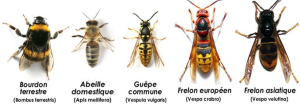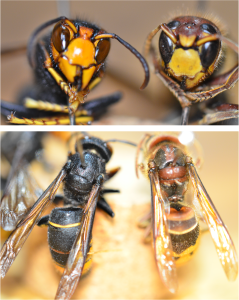Here are some general rules for those preparing to trap the Asian hornet for the first time.
Identifying the Asian hornet
Identification of the Asian hornet, scientifically known as Vespa velutina, is essential for the management of this invasive species. This hornet, native to Asia, has colonized many regions of Europe, causing environmental and economic concerns. To identify it, it is important to note its size, which is usually around 2.5 cm to 3 cm long. The Asian hornet has a distinct coloration, with a velvety black body and yellow abdominal segments. Its legs are yellow at the tips, and it has a characteristic orange face. In flight, it is distinguished by its rapid flight and distinctive buzzing sound. Accurate identification of this species is crucial for its management, as it can have a negative impact on bee populations and local biodiversity.

The Asian hornet is no more dangerous than a common wasp or bee. In most cases, it flies away rather than attacking, as bees and wasps are generally more aggressive. However, it will attack if it feels its nest is threatened. Note that its sting is larger and can be more painful.

Vespa velutina (left) side by side with Vespa Crabro (right).
The Asian hornet is darker than the European hornet. He has yellow legs and is a little smaller. It doesn’t fly at night either! If you have hornets under your street lights, they are not Asian hornets.
General diet
The Asian hornet (Vespa velutina) is a carnivorous predator, feeding primarily on other insects, particularly bees and wasps. Its diet is varied, but it has a marked preference for domestic bees, which makes it a predator feared by beekeepers. Asian hornets hunt bees, lying in ambush near hives, and they can decimate entire colonies to feed on larvae, nymphs, and adult bees.
They also hunt other insects, such as butterflies and crickets.
In addition to their meat diet, adult Asian hornets feed on flower nectar to obtain carbohydrates, which also makes them unintentional pollinators when visiting flowers. Thus, the diet of Vespa velutina may vary depending on the availability of prey and floral resources in their environment.
Diet throughout the seasons
Here is how your dietary needs change depending on the seasons, throughout the year:
Spring: In early spring, when the queen and workers begin to emerge, their main food source is flower nectar, as it provides the carbohydrates needed to support their metabolism. At this point, hunting is limited, as the colony is growing.
Summer: During the summer, when the colony reaches its maximum size, hunting for prey, especially bees and wasps, becomes more frequent. Vespa velutina larvae require a protein-rich diet, and workers intensify their hunting activities to feed the colony.
Fall: As fall approaches, the demand for protein decreases as the colony begins to produce males and future queens for reproduction. Adult Asian hornets continue to feed on nectar to support their metabolism while consuming less prey.
Winter: During winter, the colony declines, workers die, and only fertilized queens survive to found new colonies the following spring. Overwintering queens feed on nectar or honeydew if available, but their activity is reduced.
Thus, the dietary requirements of Vespa velutina vary greatly depending on the season, moving from a carbohydrate-rich diet in spring to a protein-rich diet in summer and then to a lighter diet in autumn and winter. This depends on the phase of the colony’s life cycle and the availability of food resources in their environment.
Fundamentals of trapping
Trapping is done using bait, which can be either sugar-based or protein-based, which are the two food sources that hornets seek.
These baits can attract many other insects, so it is important to ensure selective trapping. The Ornetin trap is designed in such a way that only Asian hornets are caught in the trap. Explore our detailed guide on Trapping in the Garden for insights into positioning traps and selecting baits to attract these pests. For specialized techniques focusing on apiaries and successful queen trapping, dive into our comprehensive article Trapping in the Apiary.
The European hornet must not be destroyed to safeguard biodiversity.
Preparing the ORNETIN Asian hornet trap
To make an Asian hornet trap, use the ORNETIN lid that you screw onto one of the “Le Perfect Familia Wiss” jars with a 100mm neck:
- 750 ml: Identical opening and diameter / Height: 15 cm
- 1 L: Identical opening and diameter / Height: 17.5 cm6.6.
Preparing the bait
In the vast majority of cases, sugar baits ensure a certain trapping effectiveness. If these don’t work, then consider protein baits.
With Ornetin, the baits are made of solid materials (such as a blade of straw, dry grass, cotton, wood shavings or paper towel sheets…) soaked in syrup (especially not a liquid bath). A basic bee feeding or sugar cane syrup is suitable.
Trapping period depending on its development cycle
- March, April and May: Use any very sweet syrup, cane sugar, etc.
- June, July, August and September: If sugar baits do not attract, use protein traps instead, such as salmon cat pâté, leftover raw fish, shrimp, etc.
- October, November and December: Use sugar or honey.
Discover effective strategies for trapping Asian hornet founding queens during their vulnerable spring emergence in our comprehensive article Spring Trapping. Learn essential techniques to optimize trap placement, bait selection, and monitoring to protect your apiaries effectively. Adjust your trapping methods throughout the year, using sweet syrups in spring, protein baits in summer, and sugar or honey in the fall and winter to effectively manage Asian hornet populations.
Positioning of traps
Trap placement is a very important aspect of trapping. You do not trap in the same way on an apiary, in a vegetable garden or an orchard.
Refer to the articles Trapping in the apiary and Trapping in the garden for more details.
Elimination of trapped hornets
To empty your Ornetin, immerse them in a bucket of water overnight. Don’t skimp on duration. 4 hours of diving are not enough to kill this hardy species, because once out of water, with a possible ray of sunlight, they will come back to life again!
*** Video in progress***
Conclusion
It is essential to “sugar trap” in March, April, May, October, November and December to reduce the number of founding queens. In summer, trapping aims to limit the pressure of workers on the hives. Complete elimination of the colony is usually not feasible.
Never approach an inhabited nest (up to seven hundred workers): the hornet presents a danger, especially near its nest. If you discover one from last year, in your garden or park, under cover or in a tree hollow, entrance opening downwards, place an Ornetin pot nearby, because this is where the founders will return.
